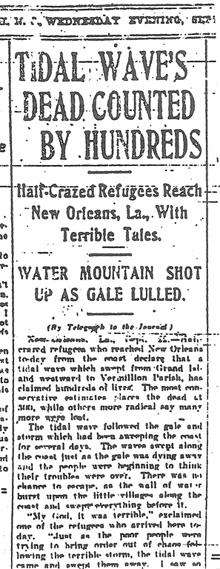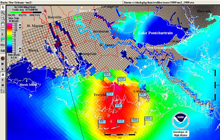Tsunami or Storm Surge?
Published accounts of historic events are an excellent source of information for researchers. However, these accounts must be carefully reviewed to ensure that what is captured is correctly interpreted and scientifically accurate.
For example, as NOAA scientists pour over old documents looking for evidence of tsunamis to include in the Global Tsunami Database, they find wording such as "wall of water" and "tidal waves." Scientists must determine if these are tsunami events or elevated sea level associated with a hurricane (i.e., a storm surge).
The story below explains how NOAA researchers used logic and modern scientific technology to debunk one such account.

Excerpt from telegraph to the Elizabeth Daily Journal, New Jersey, Wednesday evening, September 22, 1909. Click image for larger view.
By Telegraph to the Elizabeth Daily Journal, New Jersey, Wednesday Evening, September 22, 1909
New Orleans, La., Sept. 22 – Half-crazed refugees who reached New Orleans today from the coast declare that a tidal wave which swept from Grand Island and
westward to Vermillion Parish, has claimed hundreds of lives. The most conservative estimates place the deaths at 300, while others more radical say many more were
lost.
The tidal wave followed the gale and storm which had been sweeping the coast for several days. The waves swept along the coast just as the gale was dying away and the
beginning to think their troubles were over. There was no chance to escape, as the wall of water burst upon the little villages along the coast and swept everything before it.
"My God, it was terrible," exclaimed one of the refugees who arrived here today. "Just as the poor people were trying to bring order out of chaos following the terrible storm,
the tidal wave came and swept them away. I saw so many corpses that I believed for a time that I was the only survivor."
The information reveals a terrible condition. The coast line for twenty-five miles was lapped by the tidal wave; and in some places the angry water rushed into the inland for
a distance of two miles.
Tidal Waves and Hurricanes
The article, published in 1909, reports that a "tidal wave" came in after the worst of "the gale and storm" was over. So, was the wave event a hurricane storm surge or a tsunami wave caused by an offshore seismological event (earthquake) after the hurricane?
The date was added to the Global Tsunami Database in 2002, with a low validity rating (1 out of 4), meaning it was unlikely that this was a tsunami event, but needed further study. This particular event was flagged as suspect when NOAA began its intense review of the database in 2006.
NOAA has a long history of hurricane observations, including numerical measurements and text descriptions. The date of the newspaper article correlates with the Grand Isle Hurricane. This hurricane formed over Hispaniola on September 13, 1909, and made landfall at Berwick, Louisiana, on September 20. The hurricane headed inland along a path between New Orleans and Baton Rouge. A 15-foot storm surge accompanied the storm.
What about the date on the newspaper article—September 22. Does it not prove that a wave occurred two days after the Grand Isle Hurricane landfall? No, September 22 is when the article was filed by telegraph. It was the day refugees reached New Orleans from the inundated coast. After some sleuthing, NOAA researchers thus determined that the event described in the article was not a tsunami—it was a storm surge.
NOAA's SLOSH Model
New hurricane simulation models can use historical data to produce visualizations of past events. This makes it easier to assess whether a large wave is from a tsunami or from a severe storm, such as a hurricane.
Using the Sea, Lake, and Overland Surges from Hurricanes (SLOSH) model, a clear picture of the inundation is visible. SLOSH takes into account various weather and climate measurements, geographic features, and structures. The SLOSH simulation for the Grand Isle Hurricane clearly shows the inundation above normal tide.

The SLOSH simulation for the September 20, 1909, Grand Isle Hurricane. Click image for larger view.
Updating the Global Tsunami Database
So how does NOAA handle a spurious data record like this one? Do we delete the record? Oddly enough, we leave it in! We include notations that “debunk” the original tsunami designation, set the validity field to 0 (not a tsunami), and indicate that this event is of meteorological origin. If we removed the record entirely, it is likely that it would show up again in some future book or Web site, unopposed by the facts. Someone would email NOAA and say, “I found this great info about a tsunami in Louisiana in 1909. Why isn’t it listed it in your database?”
Related Web Sites
NOAA's Global Tsunami Database
